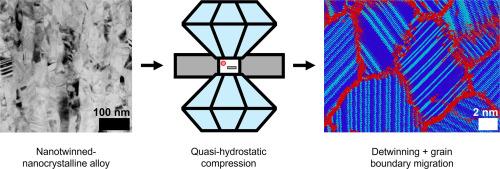高压下的纳米孪晶合金
IF 9.3
1区 材料科学
Q1 MATERIALS SCIENCE, MULTIDISCIPLINARY
引用次数: 0
摘要
纳米孪晶合金因其高强度和延展性而备受关注,但孪晶边界在剪切作用下可能不稳定。计算研究表明,高静水压力可能抑制脱孪生机制。本文研究了纳米孪晶-纳米晶铜镍合金和Inconel 725合金在高达50 gigapascal (GPa)的准静水压力下的微观组织变化。合金被压缩在金刚石砧槽中。采用原位x射线衍射(XRD)和非原位透射电镜(TEM)监测微观结构变化。在11.4 GPa的准静水压力下,铜镍合金发生孪晶界变形和晶粒长大。分子动力学(MD)模拟表明,静水压力导致晶界局部剪应力升高,从而导致原子重排。静水压力和偏压的叠加作用导致了部分位错介导的孪晶界偏移。而在12.7 GPa的准静流体压力下,Inconel 725合金表现出稳定的孪晶和晶界。推测织构、高固溶强化和低层错能是提高Inconel 725显微组织稳定性的主要原因。本文章由计算机程序翻译,如有差异,请以英文原文为准。


Nanotwinned alloys under high pressure
Nanotwinned alloys are of interest due to their high strength and ductility, but twin boundaries may not be stable under shear. Computational studies indicate that high hydrostatic pressure may suppress detwinning mechanisms. Here, we investigate the microstructural changes of nanotwinned-nanocrystalline copper-nickel and Inconel 725 alloys under quasi-hydrostatic pressures up to 50 gigapascals (GPa). The alloys are compressed in a diamond anvil cell. In-situ x-ray diffraction (XRD) and ex-situ transmission electron microscopy (TEM) were employed to monitor microstructural changes. Twin boundary deformation and grain growth occur at 11.4 GPa quasi-hydrostatic pressure in the copper-nickel alloy. Molecular dynamics (MD) simulations reveal that hydrostatic pressure causes elevated local shear stress at grain boundaries, which leads to atomic rearrangements. A superposition of hydrostatic and deviatoric pressures lead to partial dislocation mediated twin boundary migration. In contrast, the Inconel 725 alloy showed stable twin and grain boundaries up to a quasi-hydrostatic pressure of 12.7 GPa. Texture, high solid solution strengthening, and low stacking fault energy are hypothesized to the enhanced microstructural stability in Inconel 725.
求助全文
通过发布文献求助,成功后即可免费获取论文全文。
去求助
来源期刊

Acta Materialia
工程技术-材料科学:综合
CiteScore
16.10
自引率
8.50%
发文量
801
审稿时长
53 days
期刊介绍:
Acta Materialia serves as a platform for publishing full-length, original papers and commissioned overviews that contribute to a profound understanding of the correlation between the processing, structure, and properties of inorganic materials. The journal seeks papers with high impact potential or those that significantly propel the field forward. The scope includes the atomic and molecular arrangements, chemical and electronic structures, and microstructure of materials, focusing on their mechanical or functional behavior across all length scales, including nanostructures.
 求助内容:
求助内容: 应助结果提醒方式:
应助结果提醒方式:


